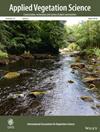Influence of Previous Coppice Management on Stand Structure and Vegetation Diversity of 9210* Habitat Beech Forests in the Central Apennines (Italy)
Abstract
Aims
Forests classified as Natura 2000 priority Habitat 9210* (Apennine beech forests with Taxus baccata and Ilex aquifolium) cover most of the European beech distribution along the Italian peninsula. Most of these forests have been coppiced for centuries until 60–70 years ago, and today, some are lapsed coppices and others in conversion to high forests. In both cases there is a lack of knowledge on the ongoing ecological dynamics, especially with regard of species composition changes, that is a base for their sustainable management.
Location
Central Apennines (Italy).
Methods
We analyzed forest structure and their impact on plant diversity from 50 plots in three sites where forests have been differently managed also in relation to their private, common or public ownership. We assessed the relationships between forest structure and understory plant diversity, applying multivariate statistical analysis and running regression models for estimating the influence of forest structure variables on species richness.
Results
We appraised the heterogeneity of the 9210* Apennines beech forests featuring five floristic-vegetation groups with cluster analysis in four structure stand types: lapsed coppices (LPC), coppices in conversion (CCO), two-layer coppices (TLC) and recolonized stored coppices (RSC). The Non-metric multidimensional scaling ordination shows that CCO, the most common structural type investigated, is not clearly related to any specific variable. The best models suggested that the mean cambial age and tree height can positively predict all dependent richness variables.
Conclusions
The structural and compositional diversities of these forests require an innovative management approach integrating silvicultural options commonly considered divergent (coppice vs. high forests) for providing new ecosystem services and socioeconomic opportunities for local mountain communities, to support biodiversity, and to increase forest resilience to natural disturbances.


 求助内容:
求助内容: 应助结果提醒方式:
应助结果提醒方式:


